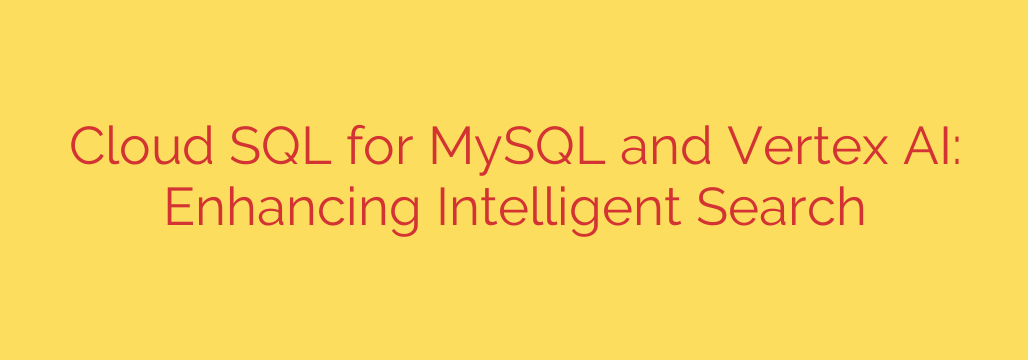
Transform Your Database Search: Integrating Cloud SQL for MySQL with Vertex AI
In today’s data-driven world, a simple keyword search is no longer enough. Users expect applications to understand context, intent, and meaning, not just exact word matches. The difference between a user finding what they need and leaving in frustration often comes down to the intelligence of your search function. Fortunately, building a sophisticated, AI-powered search experience is more accessible than ever.
By combining the reliability of a managed database like Cloud SQL for MySQL with the machine learning power of Vertex AI, you can transform a standard search bar into an intelligent discovery tool. This integration allows you to move beyond basic keyword matching and into the realm of semantic search.
The Problem with Traditional Search
Traditional database search relies on operators like LIKE or full-text search indexes. While useful, these methods have significant limitations. They struggle with:
- Synonyms: A search for “summer clothes” might miss a product described as “warm-weather apparel.”
- Context: A query for “fast laptop” requires an understanding of what “fast” means in the context of computer specifications (CPU, RAM, SSD), not just the presence of the word.
- User Intent: A user searching for “troubleshooting guide” wants conceptually related solutions, not just articles containing that exact phrase.
These limitations lead to irrelevant results and a poor user experience. To solve this, we need to teach our database to understand meaning, not just words.
Unlocking Meaning with Vertex AI and Vector Embeddings
This is where artificial intelligence, specifically Vertex AI, changes the game. The key technology behind this evolution is vector embeddings.
In simple terms, Vertex AI can transform your text data—whether it’s a product description, a user review, or an entire article—into a powerful numerical representation called a vector embedding. These embeddings capture the semantic meaning and context of the original text. Items with similar meanings will have mathematically similar vectors, even if they don’t share any of the same keywords.
By generating these embeddings for all the data stored in your Cloud SQL for MySQL database, you create a rich, searchable map of meaning.
A Practical Workflow for Intelligent Search
Integrating these two powerful platforms is a straightforward process. The workflow allows your application to find and rank results based on conceptual relevance rather than just keyword density.
Generate Embeddings: The first step is to process your existing data. You take the relevant text fields from your tables in Cloud SQL for MySQL and send them to a Vertex AI text-embedding model via an API call. Vertex AI returns a vector embedding for each piece of text.
Store the Embeddings: These newly generated vectors need to be stored alongside your original data. You can create a new column in your MySQL table (e.g., using a
BLOBorJSONdata type) to hold the vector embedding for each corresponding row. This ensures your data and its semantic meaning are tightly coupled.Perform a Semantic Search: When a user enters a search query, the process is repeated.
- Your application sends the user’s query to the same Vertex AI model to convert it into a vector embedding.
- This query vector is then compared against all the stored vectors in your Cloud SQL database.
- Using a mathematical function like Cosine Similarity, you can calculate how “close” the user’s query is to each item in your database.
- Finally, you retrieve and rank the original data from Cloud SQL based on the highest similarity scores, presenting the user with the most contextually relevant results.
The Core Benefits of This Approach
Integrating Cloud SQL with Vertex AI offers significant advantages for any application that relies on search.
- Dramatically Improved Search Relevancy: Users find what they’re looking for based on what they mean, not just what they type. This is crucial for e-commerce, knowledge bases, and content platforms.
- Enhanced User Experience: An intelligent search function reduces user friction, increases engagement, and can directly lead to higher conversion rates and customer satisfaction.
- Scalable and Managed Infrastructure: You get the reliability and scalability of Cloud SQL for your database needs and the immense power of Google’s AI models without having to build or maintain complex machine learning infrastructure yourself.
Security and Best Practices for Implementation
When integrating cloud services, security and efficiency are paramount. Keep these tips in mind:
- Secure Your API Calls: Use Google Cloud’s Identity and Access Management (IAM) with service accounts to manage permissions for Vertex AI. Avoid using hardcoded API keys in your application code.
- Optimize for Performance: Generating embeddings for a large dataset can be time-consuming. Consider using batch processing or Cloud Functions to handle this asynchronously, preventing your main application from slowing down.
- Manage Costs: Both Cloud SQL and Vertex AI are pay-as-you-go services. Monitor your usage and set up billing alerts to manage costs effectively, especially during initial development and bulk embedding generation.
- Consider Data Privacy: Be mindful of sending Personally Identifiable Information (PII) to any external service. Anonymize or redact sensitive data before generating embeddings where necessary.
By thoughtfully combining the structured data capabilities of Cloud SQL for MySQL with the semantic understanding of Vertex AI, you can build next-generation applications that are not only powerful but also intuitively intelligent.
Source: https://cloud.google.com/blog/products/ai-machine-learning/integrate-your-cloud-sql-with-vertex-ai-and-vector-search/








